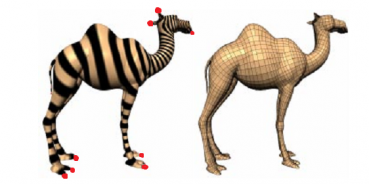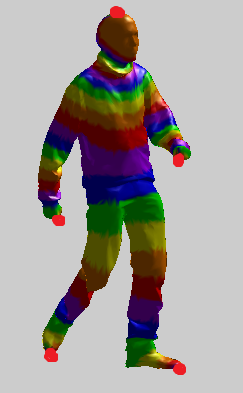利用者:Apinzonf/Gsoc2014/proposal
目次
[非表示]Interactive Quadrilateral Remeshing Based on Harmonic Functions
Name: Alexander Pinzon Fernandez
Email: apinzonf@gmail.com
IRC: apinzonf
www: http://apinzonf.wordpress.com/, http://wiki.blender.org/index.php/User:Apinzonf
Synopsis
A lot of computer graphics objects have an undesirable topology. Many artists require changing the topology of the mesh to facilitate the process of editing and animation. In recent years, the most popular mesh topology is composed of triangles and quadrilaterals that provide several desired features by the artists. This project proposes an interactive remeshing tool that generate a quad-dominant mesh based on harmonic functions.
Paper used: S. Dong, S. Kircher, and M. Garland. 2005. Harmonic functions for quadrilateral remeshing of arbitrary manifolds. Comput. Aided Geom. Des. 22, 5 (July 2005), 392-423. http://www.ideals.illinois.edu/bitstream/handle/2142/10896/Harmonic%20Functions%20for%20Quadrilateral%20Remeshing%20of%20Arbitrary%20Manifolds.pdf?sequence=2
Benefits to Blender
This project proposes a new quad remeshing tool for blender user that require improves the topology of surfaces models.
The user can define the vertices needed to find the harmonic scalar field required to compute the new topology.
Deliverables
- A new and robust quad remeshing tool for Blender.
- Some pages of documentation to be included in the manual
- A technical document for developers to improve the method in the future.
- A tutorial explaining the use of the tool.
Project Details
Basic steps to implement a quad remeshing tool based on harmonic functions.
- Interactive session with user to define features points.
- Construct the harmonic scalar field.
- Based on harmonic scalar field compute a gradient field.
- Define two orthogonal vector fields using the gradient field.
- Define a net of polygons over the original surfaces with the use of integral lines defined by the orthogonal vector fields.
- Generate a new mesh.
Project Schedule
Project Schedule 16 weeks
- 3 weeks: Interactive session with user to define features points.
- 1 week: Construct the harmonic scalar field.
- 1 week: Based on harmonic scalar field compute a gradient field.
- 1 week: Define two orthogonal vector fields using the gradient field.
- 3 week : Define a net of polygons over the original surfaces with the use of integral lines defined by the orthogonal vector fields.
- 3 week: Generate a new mesh.
- 2 weeks: Testing the tool.
- 2 weeks: Generation of the documentation and tutorials
Bio
I graduated as systems engineer in Colombia in 2007.
I am a MSc computer science student at National University of Colombia.
Skeleton extraction and mesh smoothing are the research topics of my MSc. I am use CGAL, Graphite and Qt libraries.
Since 2007 I am a member of the Bioingenium Research Group of National University of Colombia.
I have been using Blender for about 10 years. I was working on the develop of an operator to remove noise from a mesh at GSOC 2012 – Blender suchi branch “Mesh Smoothing for 3d Scan Data”.
WORK EXPERIENCE
2013 Google Summer of Code – Blender Foundation: “Laplacian Deform”.
2012 Google Summer of Code – Blender Foundation: “Mesh Smoothing for 3d Scan Data”.
2010 - Scire Foundation, Software Architect:
Design and development of web services data, hibernate and oracle.
Programming GUI with RichFaces.
Library of generic manipulation of trees, based on Java reflection techniques.
2005 - 2007 Sigtech, LTDA, Developer Engineer:
SIGC System Development for the "Departamento Administrativo de Catastro Distrital DACD".
Software used in development: Oracle 9i, Visual Basic 6, PL / SQL Developer.
2004 -2005 IIE and Colciencias, Student Monitor research:
Project: " Theater of Memory in Virtual Worlds:"
Architecture for handling streaming video that comes from a digital camcorder and put it as a texture of a 3D plane in a virtual setting, using the Java software, J3D, JMF, VRML, X3D.
SOFTWARE DEVELOPED:
Nukak3D http://sourceforge.net/projects/nukak3d
3D medical image platform for visualization and image processing.
Nukak3d is a flexible architecture that integrates general-purpose graphics libraries such as VTK, ITK, VTKInria3D, OpenGL, under a graphical user interface (wxWidgets) for three-dimensional visualization and processing of medical images. On C++.
JNukak3D http://sourceforge.net/projects/jnukak3d
Software for three-dimensional visualization of DICOM images based on java.
JVC1394 http://sourceforge.net/projects/jvc1394/
Wrapper for the library Libdc1394 to enable communication with the Java programming language. Java Video Capture for IEEE 1394 cameras. On C, C++, Java, Swig.
PUBLICATIONS
Alexander Pinzon and Eduardo Romero. 2013. Shape Inflation with an Adapted Laplacian Operator for Hybrid Quad/Triangle Meshes. In Proceedings of the 2013 XXVI Conference on Graphics, Patterns and Images (SIBGRAPI '13). IEEE Computer Society, Washington, DC, USA, 179-186. DOI=10.1109/SIBGRAPI.2013.33 http://dx.doi.org/10.1109/SIBGRAPI.2013.33
León J., Pinzón A., Sánchez C., Romero E. A distributed plugin based architecture for medical image processing. Proc. SPIE 8674, Medical Imaging 2013: Advanced PACS-based Imaging Informatics and Therapeutic Applications, 867403 (March 29, 2013);doi:10.1117/12.2007180.
Pinzón, A., Leon, J.C., Romero E., Diseño y desarrollo de una aplicación web para la visualización eficiente de imágenes medicas, con procesamiento 3D por software o por hardware. En Seminario Internacional de Procesamiento y Análisis de Imágenes Médicas SIPAIM 2009, (Noviembre 27-27, 2009), Bogotá Colombia.
Pinzón A., Romero E., Visualización 3D de imágenes médicas: una herramienta Open Source, En Seminario Internacional de Procesamiento y Análisis de Imágenes Médicas SIPAIM 2008, (Noviembre 24-27, 2008), Bogotá – Colombia.
Mendoza, B. U., Ramos, G. A., Mendez, L. M., Santamaria, W., and Pinzón, A. 2006. Camera Motion Control from a Java 3D Environment: Virtual Studio Application in Decorative Arts Museum Collections. In Proceedings of the 2006 international Conference on Cyberworlds (November 28 - 29, 2006). CW. IEEE Computer Society, Washington, DC, 58-64.

